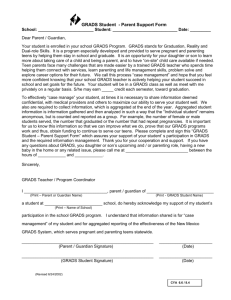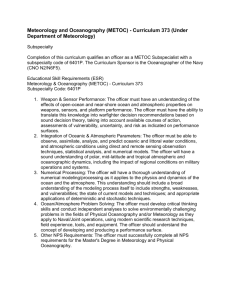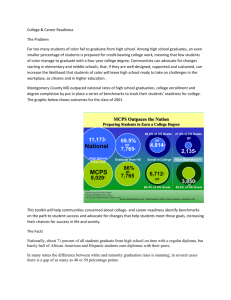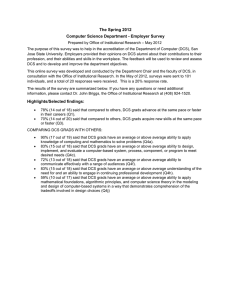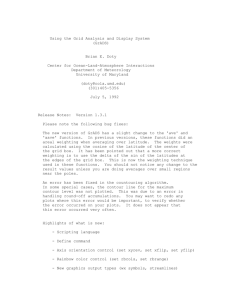ATMOSPHERIC DYNAMICS PRACTICAL LARGE
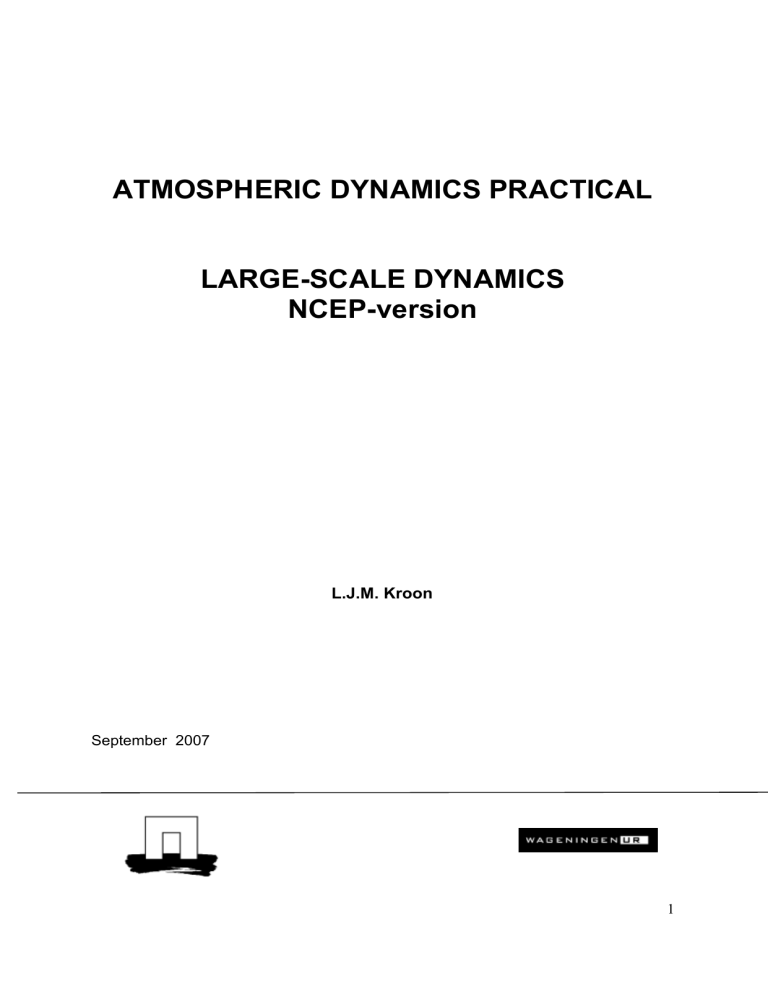
ATMOSPHERIC DYNAMICS PRACTICAL
LARGE-SCALE DYNAMICS
NCEP-version
September 2007
L.J.M. Kroon
1
1. INTRODUCTION
Traditionally, the dynamics of synoptic scale (large-scale) systems can be understood in terms of rather straightforward theoretical concepts. These are the conservation equations for mass, momentum, energy and water(vapour). Together with suitable thermodynamics these constitute all that is necessary to describe the dynamical behaviour of synoptic scale systems. However, in theory as well as in practice, matters are complicated by the complex
4-dimensional structure of the atmosphere. To keep things manageable in theoretical treatments, rigorous simplifications, often based on scale analysis, need to be made. This means that in theoretical textbooks students are only exposed to simplified systems. In order to view the atmosphere as it really is, we need to analyse real situations. In this module we have the data and the tools to do just that.
In this module we will use the Grid Analysis and Display System (GrADS) developed by
IGES (Institute of Global Environment and Society) and COLA (Centre for Ocean-Land-
Atmosphere studies). GrADS is an interactive desktop tool that is used for easy access, manipulation, and visualization of earth science data. The format of the data may be either
ASCII, binary, GRIB or NetCDF. GrADS has been implemented worldwide on a variety of commonly used operating systems and is freely distributed over the Internet. More information can be found on the GrADS homepage http://grads.iges.org/grads/.
In Section 2 an overview is given of the scope and structure of this practical, as well as the goals that we will try to achieve by performing all the units of the practical.
2. PRACTICAL: STRUCTURE AND GOALS
2.1 Introduction
Apart from having a theoretical knowledge of dynamical meteorology, operational meteorologists need to be able to use their knowledge in practice in actual situations. Only if we learn to apply theoretical concepts and principles in everyday atmospheric situations will we be able to diagnose and understand the weather. The main problem in applying theory in practice is the complexity of atmospheric motions and processes. This results in cumbersome and time-consuming calculations and produces problems in presenting results and drawing conclusions.
On computers applications have been developed for studying (predicting) atmospheric behaviour using physical-numerical models. Today, these models have become very advanced and complex. No matter how well the current models may perform, they have become too complex and comprehensive to understand fully. The result is that insight and understanding of atmospheric behaviour has decreased rather than increased.
People have imagined that soon computer models would be nearly perfect, rendering the human meteorologist obsolete. We know that knowledge and understanding of meteorology is still, now even more than before, necessary. Complex models demand an ever-increasing amount of knowledge and insight if one wants to be able to use these models and use and evaluate their output.
With the availability of personal computers and easy-to-use software we have the means of drastically reducing the tedious calculations necessary to manipulate model data.
Furthermore it is now quite easy to present the results graphically. This enables us to learn the theory step by step by applying ideas and concepts in actual situations. In this way our understanding will continue to increase with relatively little effort.
2
In developing this dynamical meteorology practical we intend to do just that. Hence our goals for this practical are:
Explain various concepts of dynamical meteorology using examples of everyday meteorological situations
Increasing knowledge and insight step-by-step by applying theoretical concepts in practice
As a bonus: proficiency with one of the commonly used graphical packages: GrADS.
2.2 Units
This practical consists of a number of units. Each unit covers a specific (small) part of dynamical meteorology. In each unit, several exercises will guide you through the material.
These exercises start by familiarization of the theory before we apply the theory to the data.
The temptation to start doing the calculations before thinking about what it is exactly what we want to do and why, and what we may expect is very real. Therefore the structure of most units is such that you have to think before you act. To this end we will usually first try to estimate quantities (order of magnitude only) using appropriate maps and only then will we perform the calculations to see if our estimates were correct. You may learn a lot from mistakes and why you have made those.
2.3 Material
For this module we have chosen a situation in January 1990 that produced a severe storm in
North-western Europe. NCEP/NCAR reanalysis data has been used to simulate this storm.
Its output is on a latitude-longitude grid, on 17 pressure levels with 6-hour intervals covering a 3-day period. The NCEP/NCAR data is in NetCDF format, a commonly used format that
GrADS is able to ingest without problems. The data is represented on a 2.5
º
2.5
º latitude longitude grid covering the entire globe, with a temporal resolution of 6 hours. These scales ensure that small-scale phenomena, often obscuring the large-scale features, have been filtered out.
2.4 Lab reports
For every unit a lab report must be made and submitted. It enables the supervisor to evaluate your progress, see where errors have been made, and also to make an assessment of your work. For the lab reports the following rules apply:
1. On every lab report clearly state on the first page only : a. the unit number and name, b. the name(s) of the student(s), c. the (submission) date.
2. Results of every exercise must be recorded, either by writing answers in a word document and/or by inserting a map or diagram in the document. Clearly indicate each exercise number.
3. The lab report should be made during the execution of the unit. Keep text to a minimum. Number all figures and write a legend for each figure indicating what has been displayed in the figure. Lab reports must be submitted electronically (by email).
2.5 Execution
It is necessary to execute the units with two persons at the same time. This not only saves valuable computer resources, but (more importantly) stimulates mutual discussion and therefore will help in understanding the material and results. It does NOT mean that one student will perform 50% of all exercises and the other student the remaining 50%, or worse that one student does all the work and the other student does nothing.
3



